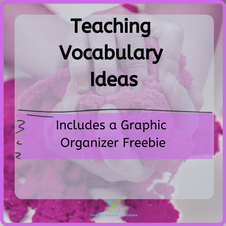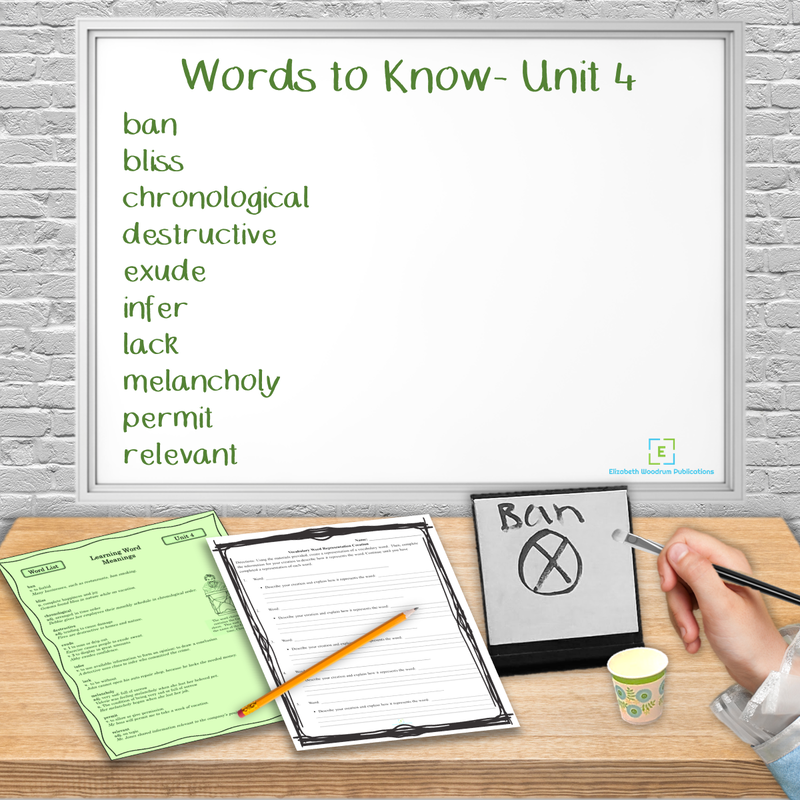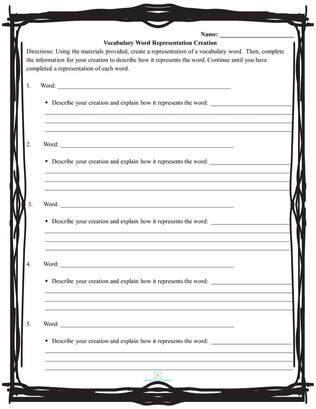
Hello, readers! It's been quite a while since I've posted on my blog. As many of you may recall, in addition to writing The Maisy Files, I'm also a teacher. Specifically, I teach sixth-grade language arts. I've decided to dedicate my first post back to a teaching topic. I've also included a freebie download that other teachers may find useful.
I would imagine that most teachers have skills they enjoy teaching more than others. Or, perhaps even just topics that they feel are more important than others. For me, that topic is vocabulary instruction. I am sure this comes from the fact that I like words. That's not surprising, is it? A teacher and author likes words! In my personal experience over the last eighteen years, I have found that the more vocabulary skills students have, the more successful they are in their comprehension and writing skills.
Direct vocabulary instruction is a topic that can get pushed aside in the effort to make sure that all of the comprehension and writing skills are covered in time for standardized testing. Yes, there are vocabulary related standards that get taught, such as understanding connotations of words and using words in context. But, I find that students are most successful when they are always learning new words while also practicing vocabulary skills. Sometimes, teachers will focus on vocabulary in novels or short stories only. While learning words that they are exposed to in long and short texts is a great way for students to learn new words, it can also be helpful to learn new words outside of texts. This can allow students the chance to focus more on practicing specific vocabulary skills while learning new words, such as learning the meanings of roots or correctly identifying the specific definition of a word as its being used in context. I often spend less time on word analysis when studying words in novels because literary analysis is my main focus at that time.
I have always made an effort to teach vocabulary units for the majority of the school year. The only time I take a break is for larger projects, such as when we are reading novels or working on large writing assignments. There is only so much that can be done in one class period. So, how can vocabulary instruction be used in a way that is not too time consuming and is also interesting for students? My approach is a combination of short, whole-class activities, centers, and technology pieces. I use a program of my own creation called Words to Know, which is available for purchase in my Teachers Pay Teachers store. The beauty of creating my own program means I am able to tailor the program to my own preferences. As with anything, it's possible to have a set of worksheets and just go through them. But, that's boring and not as likely to help students learn and master a set of vocabulary words or vocabulary analysis skills. In my Words to Know program, I introduce the words with a quick video and then we work on short activities together for context clues and a variety of other word analysis skills. But, I keep those to short, 10-15 minute lessons over several days. But, I also add extra activities that are not a part of my program. One of the most important and successful strategies for instruction is to allow students to have as many exposures to the vocabulary words as possible. So, I add center time to my vocabulary instruction as well. Incorporating movement and visual aspects in the centers provides different types of exposures to the vocabulary words, which can help students master the vocabulary being studied. If you happen to use my Words to Know program, you'll note that there are other ideas for centers in the program. But, this is something extra that I do in my own classroom and I thought I'd share it here. During each unit, students have a chance to draw and build representations of the vocabulary words. It seems simple enough, and it is. Sometimes the best ideas are the most simple. But, the strategy is also very effective. I have two products I use for these center activities: Mini Zen Boards and Mad Mattr Sensory Dough.
The Mad Mattr is clearly my students' favorite material to use to build representations of their vocabulary words. With other materials, including building blocks, available, they almost always use the dough. Sometimes, I have to remind them that they are not just having play time because they like to sit and let it run through their fingers like kinetic sand. This dough is probably best for older students who have more developed fine motor skills. It takes a little pressure to form it into solid shapes. But, students have used this dough to successfully make creations to represent their vocabulary words. I have seen everything from a simple frowning face to show melancholy to pyramids to represent ancient.
The final pieces of my vocabulary instruction include technology. I'm very lucky to have a class set of Google Chromebooks. So, most days, I let students begin our vocabulary instruction time with a few minutes of Quizlet. My sixth-graders love Quizlet. It's a website, and also an app, that allows students to review words and their meanings. They can complete a variety of activities, and I always let them have their choice. There are simple flash cards and more interactive games. The Gravity game is quite popular. Once a unit, we also play Quizlet Live, which is a group game. They get very competitive and the strong emotion involved in competition is another way to sear knowledge into the brain. The other piece of technology I use is Kahoot. Once a unit, usually the last day before the assessment, we play a Kahoot game. Kahoot is a game students play as individuals where they try to answer vocabulary related questions correctly and quickly. While I use Kahoot for vocabulary, you can make games for any topic.
Both Kahoot and Quizlet are free, though there are paid options for both. It's pretty quick to set up activities for both to allow your students to practice their vocabulary words. If you are looking for a new vocabulary program though, my Words to Know program includes Quizlet and Kahoot activities for each unit. You can check out the program here or view a free sample here. I hope you've enjoyed reading about how I incorporate vocabulary instruction into my regular plans and that you've perhaps gained some ideas. I firmly believe that the more words students know and the better they are at analyzing words, the more successful students they will be. Please feel free to share your thoughts and your own vocabulary instruction ideas in the comments!
0 Comments
Leave a Reply. |
Elizabeth Woodrum's Blog
Author of AboutElizabeth Woodrum is the author of the children's book series, The Maisy Files. She is also a full-time teacher and creator of teaching materials that can be found on Teachers Pay Teachers. This blog is a mix of teaching and author topics. Categories |




